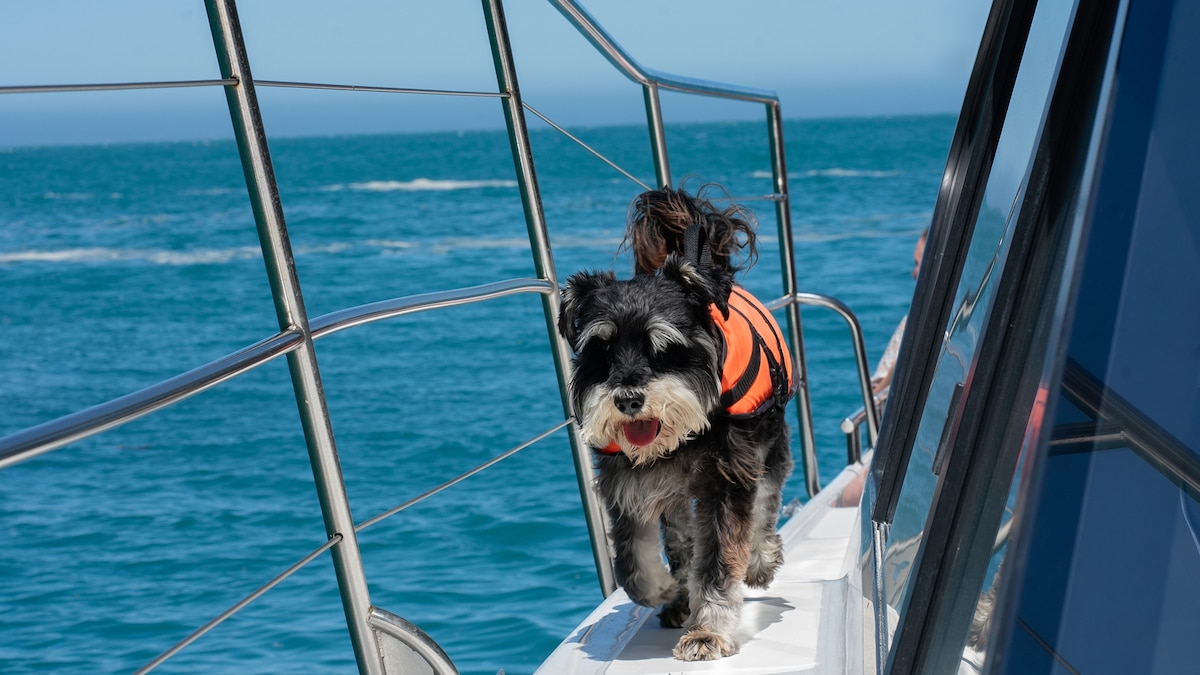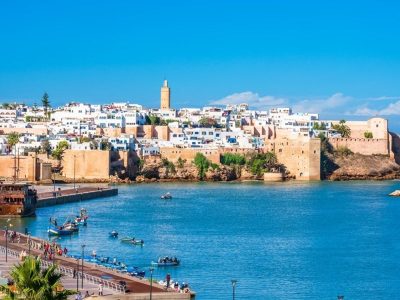This article was produced by National Geographic Traveller (UK).
Buster’s ears perk up as he paces the starboard, scanning the vast expanse of milky blue waters. He sees something, or rather hears something.
“Dogs have remarkable hearing,” explains George Waghorn, skipper and co-owner of nature cruise operator Akaroa Dolphins, “they tune into the clicks and whistles of dolphins communicating.”
Attentive as ever, Buster angles his head towards the water as if eavesdropping on a conversation. His eyes fix on the glassy water, which breaks as two dolphins emerge from the depths. While passengers rush to the starboard side in excitement, Buster remains composed, his duty — to spot the world’s smallest and rarest marine dolphins, the Hector’s dolphin — fulfilled.
The salt and pepper-coloured dolphins, with their svelte bodies and rounded dorsal fins, will only venture up to around 30 miles from Akaroa Harbour, explains George, rendering the waters I find myself bobbing in the sole destination to observe some of the 7,000 or so Hector’s dolphins left in the world.
On the microphone, George shares history about Akaroa, the place his family has called home for seven generations (and counting). Akaroa, derived from the Māori term for ‘long harbour’, owes its existence to the volcanic eruption that cleaved the earth, allowing the ocean to rush in and shape the Banks Peninsula. “If you were to push the mountains together, they would line up,” he says, pointing towards the escarpments crowning each peak encircling us as we exit the harbour.

Akaroa, New Zealand is a favoured weekend retreat for city dwellers nearby. Photograph by Michael Williams, Alamy
Just a 90-minute drive from Christchurch, Akaroa stands as a favoured weekend retreat for city dwellers, but the uniqueness lies in its history. In 1840, French settlers had plans to be the first colonisers to plant their flag. However, despite arriving later, the British were quick to sign the Treaty of Waitangi with Māori chiefs, resulting in the shared governance of the town. This revelation hastened the signing of the Treaty of Waitangi between the British Crown and Māori chiefs, resulting in the shared governance of the town. This historical convergence is reflected in the town’s streets, with French-named thoroughfares like Rue Lavaud coexisting alongside British street names. It only takes 15 minutes to walk from one end of the town to the other.
The Waghorns, with a mix of French and British heritage, founded Akaroa Dolphins two decades ago after selling their farm. Acquiring the fishing charter mainly for its dolphin permits, Hugh and Pip Waghorn never anticipated its growth beyond a hobby. Today, their children, George and Julia, manage the day-to-day operations, along with their trusty roster of staff, including both humans and canines.
“Like us, the dogs follow a schedule,” says George. Albie, his faithful English springer spaniel, who joins us on the next cruise, has been sailing since he was barely out of puppyhood. “He’s well-tuned to the dolphin’s frequency,” explains George, as Albie, splayed out next to me, hangs his head over the edge as far as it can go to watch the dolphins coast below.

The dogs have bee trained not to bark, in order to avoid disturbing the dolphins. Photograph by Natasha Bazika
Dolphin dogs, unlike their airport security counterparts, undergo minimal formal training. “It’s more about nurturing their innate instincts,” says George. The primary focus is on teaching them not to bark. Barking could disturb the dolphins. Each dog has its mentor to show them the ropes.
The inaugural dolphin dog was Hector, Hugh and Pip’s beloved cairn terrier. They took him on board their sailing boat and soon discovered he could tune into the dolphins’ calls. “There was this moment when Hector and the dolphins were playfully chasing each other up and down the boat,” Pip recalls. “Animals have these superpowers that we lack — it’s magical to watch.”
Since then, dogs have joined the family through a stroke of serendipity — almost as if fate had a hand in it. Julia recounts how Albie came into their lives when a local proposed a trade: Albie for a private cruise. As for Jet, George’s companion, he originally resided in the Australian outback until Pip brought him back to Akaroa with George in tow, a move she describes as nothing short of a blessing.

Akaroa Dolphins is New Zealand’s first tourism activity to be B Corp certified. Photograph by Natasha Bazika
While Hector’s dolphins are the top attraction in town, with numerous tourism operators offering cruises, Akaroa Dolphins is New Zealand’s first tourism activity to be B Corp certified. “Some places allow swimming with the dolphins; we prefer not to encourage it,” explains Julia. “We see our role as educators, providing guests with an experience while leaving a minimal environmental footprint.” A family trait, it seems
In 2014, Pip and Hugh helped establish the Akaroa Marine Reserve, aimed at safeguarding not only the dolphins but also other marine inhabitants like kororā — white-flippered penguins — and New Zealand fur seals. During our two-hour cruise, we’re fortunate to spot a significant resident population of these fascinating creatures, along with white-fronted terns flittering above the rough seas at the entrance to the ocean.
On the way back, Buster sashays between passengers, grabbing as many pets and ‘atta boys’ as possible. Despite the dolphins surrounding us, in that fleeting moment, all eyes are on Buster.
Get to Akaroa from Christchurch on the Akaroa French Connection shuttle service, departing Christchurch at 9am and leaving Akaora 4pm, NZ$65 (£31) for an adult return.
Akaroa Dolphin’s two-hour cruises depart from Akaroa Wharf at 12.45pm (year-round), 10.15am and 3.15pm (seasonal), priced at £53 for adults.
Consider a longer stay at Akaroa Waterfront Motels, offering self-contained waterfront studios NZ$179 (£86) per night.
This story was created with the support of Tourism New Zealand and ChristchurchNZ.










